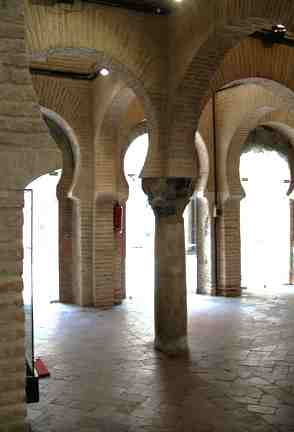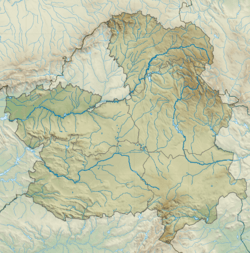Mosque of las Tornerías facts for kids
Quick facts for kids Mosque of las Tornerías |
|
|---|---|
|
Spanish: Mezquita de las Tornerías
|
|

Prayer hall on the former mosque's upper floor
|
|
| Religion | |
| Affiliation | Islam (former) |
| Ecclesiastical or organisational status |
|
| Status |
|
| Location | |
| Country | Spain |
| Architecture | |
| Architectural type | Mosque architecture |
| Architectural style | Moorish |
| Completed | c. 11-12th century |
The Mosque of las Tornerías is a very old building in Toledo, Spain. It was once a mosque, a place of worship for Muslims. This building was constructed around the middle of the 11th century. It was built on top of even older Roman foundations.
The mosque is located in an old Muslim area called Arrabal de Francos. Today, it is no longer a mosque. It now houses the "Center Foundation of Promotion of the Crafts." You can visit this center to see different art and craft exhibitions.
History of the Building
This building continued to be used as a mosque for a long time. It stayed a mosque even after Christian armies took over Toledo in 1085. This period is known as the reconquista, when Christian kingdoms took back control of Spain.
The mosque was used for Islamic worship until about 1498 to 1505. After that, it was no longer used as a religious building. It became a regular building for everyday use. In 1505, it was used as an inn, which is like a hotel. Later, it became home to various businesses and small factories. It was also used as a simple house.
For many years, people forgot its history. Then, in the late 1800s, historians started to investigate its origins. They weren't sure if it was a synagogue or a mosque at first. After careful study, on March 15, 1905, it was officially announced that it was an old Arab mosque. This discovery was shared with the Real Academia de la Historia, a famous historical group.
Amazing Architecture
Historians believe this former mosque was finished sometime between the late 11th century and the late 12th century. It was built on the walls of ancient Roman water tanks. These tanks were used to supply drinking water to the city.
The ground where it was built is very uneven. This allowed the mosque to have two floors, which is quite unusual. You can enter the ground floor from the street. This floor opens up to the Roman water tanks, which have cool granite arches.
The upper floor was the main prayer area. You can still see parts of the mihrab there. The mihrab is a special niche in the wall that shows the direction of Mecca, which Muslims face during prayer. You can also see parts of the qibla wall, which is the wall containing the mihrab.
The design of this mosque was inspired by another important mosque in Toledo. This was the Mosque of Cristo de la Luz, also known as Bab al-Mardum, built in the 10th century. The Mosque of las Tornerías has an irregular square shape. Its inside spaces are organized into nine square sections. These sections are covered by brick domes. The central dome is especially interesting because it has a unique ribbed design. The building also features horseshoe arches resting on short columns with large, decorative capitals.
Gallery
See also
 In Spanish: Mezquita de las Tornerías para niños
In Spanish: Mezquita de las Tornerías para niños
- Mosque of Cristo de la Luz
- List of former mosques in Spain







